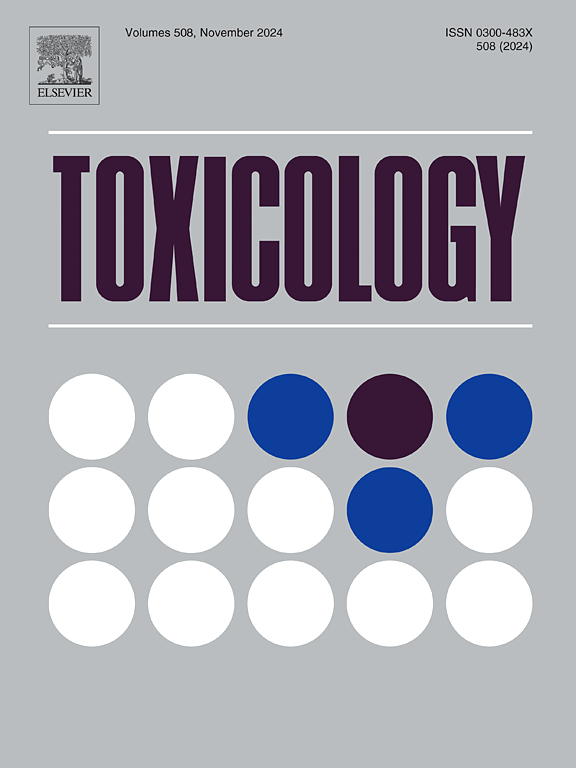镉诱导的肠道失调先于小鼠海马依赖性学习和记忆缺陷的发生
IF 4.6
3区 医学
Q1 PHARMACOLOGY & PHARMACY
引用次数: 0
摘要
镉(Cd)是一种被认为是神经毒性的重金属,但其神经毒性的详细机制仍未完全阐明。肠-脑轴——肠道微生物群和中枢神经系统之间的双向通讯途径——与各种神经系统疾病有关。由于Cd靶向肠道微生物组,因此研究该轴是否有助于Cd诱导的神经毒性是很重要的。在这项研究中,成年雄性小鼠通过饮用水暴露于环境相关水平的Cd(3 mg/L) 9周。在整个暴露期间评估认知功能,并每两周收集粪便样本以跟踪肠道微生物组的变化。我们发现,Cd暴露在认知缺陷发生之前就引起了肠道生态失调,特定的细菌种类与认知障碍有关。RNA测序揭示了海马中与认知和神经炎症有关的基因表达的改变。此外,Cd暴露降低了与肠屏障完整性相关的基因的表达,增加了炎症细胞因子的水平,并改变了神经活性微生物代谢物的水平。这些发现表明肠-脑轴在介导Cd神经毒性中起关键作用,并强调肠道微生物组是预防或减轻Cd诱导的认知能力下降的治疗策略的潜在靶点。本文章由计算机程序翻译,如有差异,请以英文原文为准。
Cadmium-induced gut dysbiosis precedes the onset of hippocampus-dependent learning and memory deficits in mice
Cadmium (Cd) is a heavy metal recognized as a neurotoxicant, but the detailed mechanisms contributing to its neurotoxicity remain to be fully elucidated. The gut-brain axis—a bidirectional communication pathway between the gut microbiome and the central nervous system—has been implicated in various neurological disorders. Since Cd targets the gut microbiome, it is important to investigate whether this axis contributes to Cd-induced neurotoxicity. In this study, adult male mice were exposed to environmentally relevant levels of Cd (3 mg/L) via drinking water for nine weeks. Cognitive function was assessed throughout the exposure period, and fecal samples were collected biweekly to track changes in the gut microbiome. We found that Cd exposure caused gut dysbiosis before the onset of cognitive deficits, with specific bacterial species correlating with impaired cognition. RNA sequencing revealed alterations in the expression of genes involved in cognition and neuroinflammation in the hippocampus. Additionally, Cd exposure reduced the expression of genes related to intestinal barrier integrity, increased levels of inflammatory cytokines, and altered the levels of neuroactive microbial metabolites. These findings suggest a critical role for the gut-brain axis in mediating Cd neurotoxicity and highlight the gut microbiome as a potential target for therapeutic strategies to prevent or mitigate Cd-induced cognitive decline.
求助全文
通过发布文献求助,成功后即可免费获取论文全文。
去求助
来源期刊

Toxicology
医学-毒理学
CiteScore
7.80
自引率
4.40%
发文量
222
审稿时长
23 days
期刊介绍:
Toxicology is an international, peer-reviewed journal that publishes only the highest quality original scientific research and critical reviews describing hypothesis-based investigations into mechanisms of toxicity associated with exposures to xenobiotic chemicals, particularly as it relates to human health. In this respect "mechanisms" is defined on both the macro (e.g. physiological, biological, kinetic, species, sex, etc.) and molecular (genomic, transcriptomic, metabolic, etc.) scale. Emphasis is placed on findings that identify novel hazards and that can be extrapolated to exposures and mechanisms that are relevant to estimating human risk. Toxicology also publishes brief communications, personal commentaries and opinion articles, as well as concise expert reviews on contemporary topics. All research and review articles published in Toxicology are subject to rigorous peer review. Authors are asked to contact the Editor-in-Chief prior to submitting review articles or commentaries for consideration for publication in Toxicology.
 求助内容:
求助内容: 应助结果提醒方式:
应助结果提醒方式:


